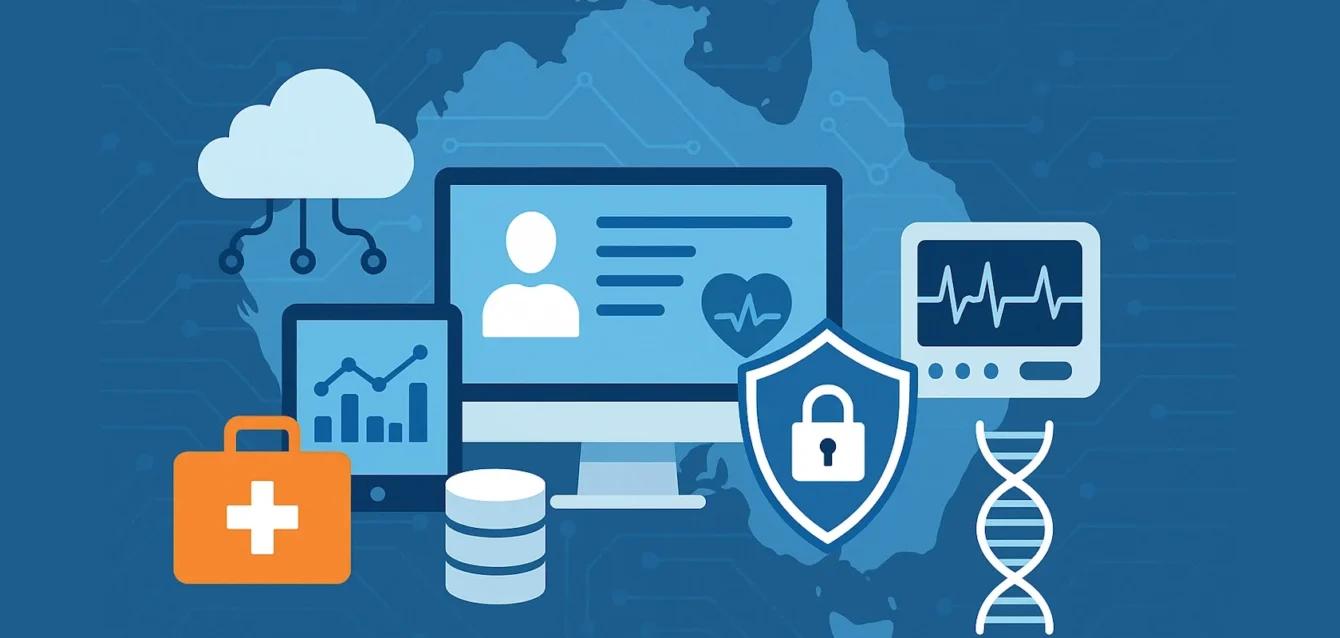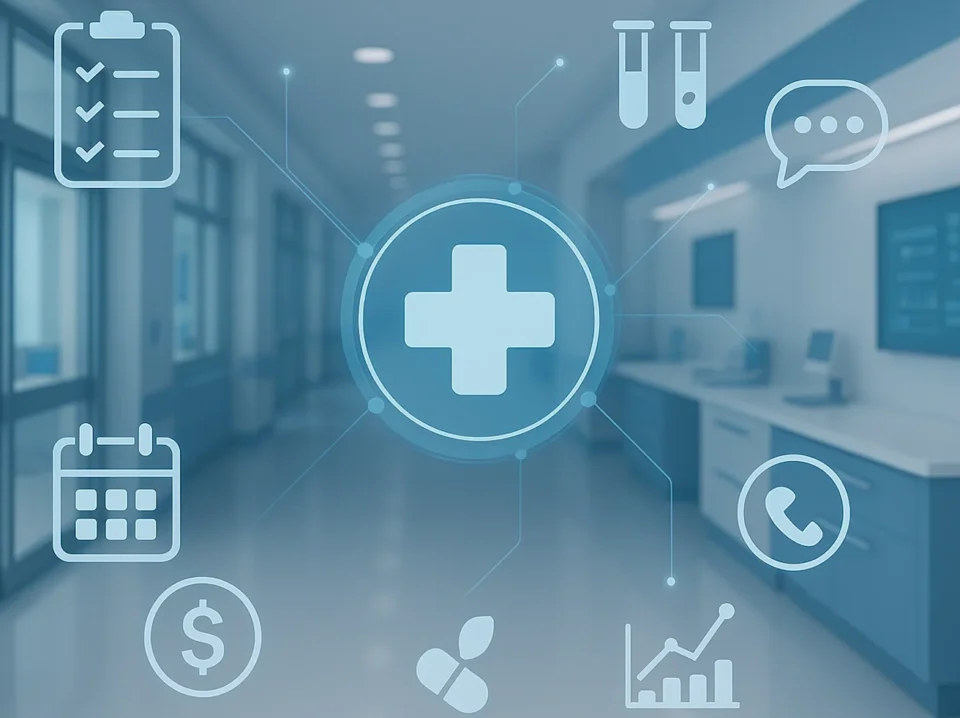Australia’s healthcare and life sciences sectors must deliver more care, more research, and more innovation, under tight budgets and strict regulation. Digital healthcare solutions give leaders a practical way to hit those targets. By bringing together cloud for healthcare, governed data pipelines, AI in healthcare solutions, and defence‑in‑depth cybersecurity, organisations improve efficiency, compliance, and patient care. The payoff is real: faster decisions, fewer manual tasks, and resilient operations across care and research. This article explains why these capabilities matter, the key building blocks, and how Australian organisations can adopt them safely to drive measurable outcomes for patients and teams. Digital transformation is not about buying tools; it’s about connecting data, automating workflows, and securing every layer. Done well, it reduces risk while lifting quality of care.
Why Digital Healthcare Solutions Matter
The shift to data-driven healthcare
Clinical and operational decisions depend on timely, high‑quality data. Integrating electronic medical records, imaging, labs and devices into governed platforms enables real‑time dashboards, predictive alerts, and population insights. Done well, data moves securely between systems and is simple to analyse, share, and audit.
Challenges faced by healthcare & biotech organizations
Even leaders face hurdles:
-
Fragmented systems that don’t interoperate (EMR, LIMS, ERP, CRM, PACS).
-
Legacy infrastructure that is hard to scale or secure.
-
Regulatory complexity across Australian Privacy Principles, ADHA guidance, and TGA obligations.
-
Escalating cyber threats targeting hospitals and labs.
-
Talent shortages that make manual work and rework common.
These challenges slow breakthroughs and increase operational risk.
Key Components of Digital Healthcare Solutions
Cloud management for secure and scalable infrastructure
Cloud platforms provide resilient, scalable computing that meets data‑residency needs in Australia. A well‑architected cloud for healthcare uses identity‑centric access, encryption, backup strategies, and cost control through right‑sizing and automation. Hybrid and edge patterns keep sensitive workloads close to care settings and support imaging and real‑time telemetry.
Data pipelines for faster, accurate insights
Modern data pipelines collect, validate, and route data from EMR, LIMS, wearables, and medical devices into trusted stores. Using ELT/ETL, streaming ingestion, and data quality checks, teams gain reliable, near‑real‑time views of operations. Interoperability matters: support for HL7/FHIR, DICOM, and secure APIs ensures information flows safely between systems.
AI in healthcare solutions for diagnostics, workflows, and innovation
AI turns data into action. Computer vision can flag urgent findings on radiology images. NLP can summarise clinician notes and extract key concepts for coding or research. Predictive models forecast readmissions, sepsis risk, or operating‑theatre demand. In biotech, AI accelerates target discovery and study design. Safe adoption requires human‑in‑the‑loop validation, bias monitoring, model explainability, and MLOps practices for versioning, drift detection, and secure deployment.
Cybersecurity for medical data and devices
Cybersecurity in healthcare is mission‑critical. Combine zero‑trust access, network micro‑segmentation, vulnerability management, and 24×7 threat monitoring. For devices, maintain software bills of materials, isolate networks, and apply secure over‑the‑air updates to protect safety and uptime.
Supporting Medical Devices and Biotech Innovation
How robust digital support ensures compliance and reliability
Biotech and device makers operate in regulated environments. Robust digital support provides audit trails, validated environments (GxP), and secure collaboration across research partners. Automated testing and documented change control reduce release risk. With harmonised data and evidence, teams can accelerate submissions.
Streamlining device integration with secure data systems
Connected devices generate valuable signals—from infusion pumps and wearables to imaging modalities. Secure integration pipes this telemetry through API gateways and data pipelines to analytics and care platforms. Edge runtimes help monitor fleets and push updates securely.
Impact on Workflows, Productivity, and Patient Outcomes
Reducing manual inefficiencies
Paper, spreadsheets, and swivel‑chair data entry add delays and errors. Workflow automation replaces repetitive tasks like appointment reminders, claims pre‑checks, sample tracking, and inventory management. Role‑based dashboards surface the right information at the right time, shrinking queues and theatre overruns while improving revenue integrity.
Empowering staff to focus on patient care
When systems interoperate and data is dependable, clinicians and researchers gain back hours each week. Single sign‑on, smart forms, and context‑aware assistance reduce clicks and cognitive load. Teams spend more time with patients and make quicker, safer decisions from a shared, up‑to‑date view of the patient journey.
Driving biomedical innovation in Australia
Australia’s research hospitals, universities, and start‑ups are engines of biomedical innovation. Secure data sharing, privacy‑preserving analytics, and cloud‑based workbenches enable multi‑site studies without unnecessary data movement. Rural and remote communities benefit as telehealth, remote monitoring, and decision support bring specialist expertise closer to home.
Partnering for Success in Healthcare and Biotech
At DataTech Consultants, we deliver comprehensive solutions—including cloud management, setting up and managing data pipelines, AI integration, computer vision, and cybersecurity—all tailored for healthcare and biotechnology companies. These services help streamline workflows, enhance productivity, and ultimately drive better patient outcomes.
Our partnership model is simple and outcome‑focused:
-
Discovery & roadmap: Assess current systems and risks, then design a pragmatic, staged plan.
-
Security by design: Zero‑trust, least‑privilege, and encryption practices embedded from day one.
-
Compliance alignment: Architectures and documentation that support APPs, ADHA guidelines, GxP, ISO 13485, and TGA expectations.
-
Build & integrate: Cloud landing zones, governed data platforms, and interoperable APIs that connect EMR, LIMS, PACS, and device telemetry.
-
AI responsibly: Use‑case selection, model evaluation, MLOps pipelines, and human oversight to keep AI safe and useful.
-
Upskill & manage: Training, change management, and managed operations so your teams are confident and supported.
FAQs
What is the role of AI in healthcare solutions?
AI augments clinicians and researchers with faster insights—from imaging triage and note summarisation to risk prediction and resource planning. With strong governance and MLOps, it becomes a safe co‑pilot that boosts accuracy and speed.
How do digital healthcare solutions improve patient care?
They reduce delays and errors by integrating data, automating routine tasks, and surfacing real‑time insights. Teams can coordinate care, personalise treatments, and intervene earlier—lifting outcomes and experience.
What challenges do digital solutions solve for medical device companies?
They enable secure connectivity, fleet management, and data capture for post‑market surveillance. Standardised pipelines and audit trails support submissions, while cybersecurity protects IP and patient safety.
Are these solutions compliant with Australian regulations?
Yes—architectures can align with Australian Privacy Principles, ADHA interoperability guidance, and TGA expectations. Clear governance, access controls, and validation evidence help pass audits and maintain trust.
How quickly can organisations see value?
Start with a focused use case—such as a data pipeline for theatre utilisation or an AI tool for imaging prioritisation—and realise benefits within weeks. Iterative delivery compounds value while reducing project risk.
Conclusion
Adopting digital healthcare solutions is one of the most effective ways to lift efficiency, strengthen compliance, and improve patient outcomes across Australia’s healthcare and life sciences ecosystem. By uniting cloud, data pipelines, AI, and cybersecurity, organisations can modernise safely and at pace. If you’re ready to turn complex systems into connected, insight‑driven care, partner with experts who build for outcomes—so your teams can focus on what matters most: patients.





